Best soccer fields in the world
Given the global popularity of football, numerous stadiums across the globe embody the essence of the sport. These venues vary in size and design, tailored to the specific level of fan support they attract. Here are best soccer fields in the world
ALSO CHECK:Weekend premier league fixtures
Determining the ultimate soccer fields worldwide is a challenging task, but the following five undoubtedly make the shortlist for those eager to delve into the array of options available for exploration.
A. Wembley stadium [London, England]:
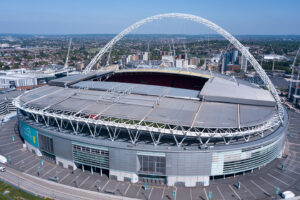
Since the grand opening of the stadium in 2007, the English National Team’s home has certainly been a place that every single football fan would love to check out.
It took the place of the original Wembley Stadium that opened in 1923, and it has instantly become an electric venue for huge matches. Matches like the FA cup finals and other big games are normally hosted there.
Wembley Stadium is a renowned football stadium located in London, England. It’s a historic venue that has hosted numerous sporting events, concerts, and other major gatherings.
It has a capacity of over 90,000 people and is known for its iconic arch.
ALSO CHECK:Most creative midfielders in the world 2023
Wembley Stadium’s history dates back to 1923 when the original stadium, known as the “Empire Stadium,” was completed.
It was constructed for the British Empire Exhibition and hosted its first event, the FA Cup Final, on April 28, 1923.
The original stadium had a twin-towered facade and was designed to hold a large number of spectators. Over the decades, Wembley Stadium became an iconic venue for football (soccer) matches, including England’s home games. It also hosted various other sports events, concerts, and important cultural gatherings.
In the early 2000s, the decision was made to rebuild Wembley Stadium due to its aging infrastructure. The new Wembley Stadium was inaugurated in 2007, with a distinctive arch that became a prominent feature of the design. The new stadium retained the historical significance of the original while incorporating modern amenities and technology.
The process of building the new Wembley Stadium involved careful planning, design, and construction to ensure it could accommodate the diverse range of events that take place there today.
Most notable Events:
1.1996 FIFA world cup final: Perhaps this is the most famous event held at Wembley, this match saw England win their first and only World Cup by defeating West Germany 4:2 after extra time.
1985 Eurpean cup final: While not a positive moment, the tragic Heysel Disaster occurred during the European Cup Final between Liverpool and Juventus, resulting in the deaths of 39 people. This event had a significant impact on stadium safety and football culture.
1992 summer Olympics: Although not a game, Wembley Stadium hosted football matches during the 1992 Barcelona Olympics, showcasing international talent.
1996 UEFA European championship: Wembley hosted the semi-finals and final of Euro 1996, with Germany defeating the Czech Republic to win the championship.
2007 UEFA champions league final: The first final in the newly rebuilt Wembley Stadium, AC Milan faced Liverpool in a rematch of the 2005 final. Milan won this time, securing their seventh European Cup/Champions League title.
The above mentioned games are just a few examples of the iconic games and events that have taken place at Wembley Stadium. It has a rich history of hosting significant moments in sports and culture.
ALSO CHECK:Chelsea at the verge of signing moises caicedo
B. Camp Nou [Barcelona, Spain]
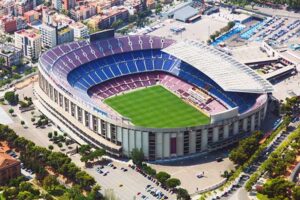
Barcelona’s Camp nou replaced their old ground of Les Corts which with a capacity of just 48,000 was too small to accomodate the interest generated by a team led by Hungarian star Ladislao Kubala.
The stadium was designed by architects Francesc Mitjans Miró and Josep Soteras Mauri, with the collaboration of Lorenzo García Barbón, and it was constructed between 1955 and 1957, using mainly concrete and iron.
The whole project cost a staggering 288 million pesetas, which meant the club would spend the following years heavily in debt.
Although it was originally going to go under the official name of ‘Estadi del FC Barcelona’, it soon came to be popularly known as the ‘Camp Nou’ (the ‘new ground’), as opposed to the club’s old home at Les Corts.
It was not until the 2000/2001 season that, following a postal vote made by the Club membership, that the decision was made to make ‘Camp Nou’ the official name of the stadium. Of the 29,102 votes the club received, a total of 19,861 (68.25%) preferred Camp Nou to Estadi del FC Barcelona.
The stadium’s maximum height is 48 metres, and it covers a surface area of 55,000 square metres (250 metres long and 220 metres wide). In accordance with UEFA stipulations, the playing area has been downsized to 105 metres x 68 metres.
With a capacity of 99,354, it is now the biggest stadium in Europe. However, the total capacity has varied over the years owing to different modifications.
When it was first opened in 1957, it held 93,053 spectators, which would be increased to 120,000 in 1982 on occasion of the FIFA World Cup. However, the introduction of new regulations outlawing standing areas reduced the stadium’s capacity in the late 1990s to just under 99,000.
In the 1998-99 season, UEFA recognised the services and facilities at Camp Nou by awarding it five star status.
In 2010, in line with the new UEFA regulations, this category was replaced by the new ‘Category 4’ title which corresponds to the stadiums which fulfill the most demanding requirements with regards to facilities, services and capacity such as FC Barcelona’s ground.
Of the different facilities on offer inside the stadium, of particular note are a chapel next to the changing rooms, the presidential box, the VIPs lounge, the press rooms, several television studios, the Sports Medicine Centre, the Operative Control Unit (UCO), the veteran players area, the FC Barcelona club museum, and the offices of all of the many different Club departments.
Camp Nou is the home stadium of FC Barcelona, one of the most renowned football clubs in the world. It is located in Barcelona, Spain, it’s one of the largest stadiums in Europe and has a seating capacity of around 99,000, making it an iconic venue for football matches.
The stadium has witnessed numerous historic moments in football history and is known for its vibrant atmosphere during matches.
It has been a crucial part of FC Barcelona’s identity and a popular destination for football fans around the globe.
Special features are:
Size and capacity: it’s one of the largest football stadiums globally, with a seating capacity of around 99,000 spectators, providing an unparalleled atmosphere during matches.
History and tradition: Camp Nou has been the home of FC Barcelona since its completion in 1957, holding decades of football history, legendary matches, and countless memorable moments.
Architecture: The stadium’s design is a blend of modernity and functionality. Its unique, steep grandstands offer excellent visibility for spectators, creating an intimate connection between fans and the game.
Barca passion: The stadium is a symbol of FC Barcelona’s identity and the “Barça” philosophy. It’s a place where fans passionately support their team, creating an electric atmosphere that contributes to the club’s success.
European Nights: Camp Nou has hosted numerous high-stakes UEFA Champions League matches, known for their intense atmosphere and thrilling football moments.
These factors, among others, contribute to Camp Nou’s special place in football history and the hearts of fans worldwide.
C. Santiago Bernabeu [ Madrid, Spain]:
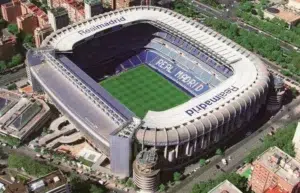
The Santiago Bernabeu Stadium is a football stadium in Madrid, Spain. With a current seating capacity of 83,168, it has the second-largest seat capacity in Spain, and it has been the home stadium of Real Madrid since its completion in 1947.
The field is named after footballer and legendary Real Madrid president Santiago Bernabéu (1895–1978), the stadium is one of the world’s most famous football venues.
It has hosted the final of the European Cup/UEFA Champions League on four occasions: in 1957, 1969, 1980, 2010. The stadium also hosted the second leg of the 2018 Copa Libertadores Finals, making Santiago Bernabéu the first and only stadium to host the two most important premier continental cup finals which are UEFA Champions League and Copa Libertadores.
The final matches for the 1964 European Nations’ Cup and the 1982 FIFA World Cup were also held at the Bernabéu, making it the first stadium in Europe to host both a UEFA Euro final and a FIFA World Cup final.
Brief historical background of the field
On 22nd June 1944, the Banco Mercantil Industrial bank granted credit to Santiago Bernabéu and Rafael Salgado for the purchase of the land adjacent to the old Chamartín Stadium.
On 5th September 1944, architects Manuel Muñoz Monasterio and Luis Alemany Soler were hired and the structure on the site began to give way to the new stadium.
On 27th October 1944, construction work on the stadium began, which was being built partly on the old site and on the grounds of Villa Ulpiana. In the meantime, Real Madrid played its home games at the Estadio Metropolitano in the 1946–47 season and at the start of the 1947–48 season.
The stadium was inaugurated on 14th December 1947 with a match between Real Madrid and the Portuguese side Os Belenenses. After the preliminaries, at 15:30 referee Pedro Escartín from the Madrid school started the match.
Real Madrid striker Sabino Barinaga scored the first goal in the 15th minute with a header. At the end of the match, Barinaga received a recognition pennant. Afterwards, players and managers of both teams celebrated with a dinner.
The first official match took place on 28th December 1947 on matchday 12 of La Liga against Atlético de Bilbao, which had been postponed due to the inauguration of the stadium.
The match was refereed by José Fombona Fernández from the Asturian school and ended with a 5:1 victory for Los Blancos. The first goal was scored in the 4th minute by Madrid midfielder Chus Alonso after receiving a pass from Barinaga.
The stadium has a seating capacity of around 83,168 spectators and has hosted numerous high-profile matches, including domestic league matches, UEFA Champions League finals, and international fixtures. It has undergone several renovations and expansions over the years, making it an iconic landmark in the world of football.
Most notable events:
1964 Eurpean cup final: Inter Milan defeated Real Madrid 3-1 to win the European Cup (now called UEFA Champions League) in a dramatic final.
1982 FIFA world cup: The stadium hosted several matches during the 1982 World Cup, including the final where Italy triumphed over West Germany 3-1.
2002 UEFA champions league final: Real Madrid defeated Bayer Leverkusen 2-1 in a thrilling final, with Zinedine Zidane’s famous volley goal.
El clasico: The stadium is the backdrop for the intense rivalry between Real Madrid and FC Barcelona, known as El Clásico. These matches have produced countless iconic moments.
2010 FIFA world cup qualifiers: Spain defeated Turkey 6-0 in a World Cup qualifier, showcasing their dominance on home turf.
The above are just a few examples, and the stadium’s history is rich with many more remarkable matches that have left a lasting impact on football fans worldwide.
D. Old Trafford [Manchester, England]:
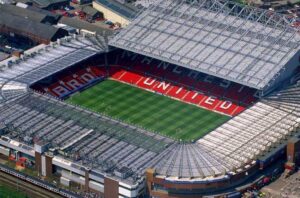
Old Trafford is a football stadium in Old Trafford, Greater Manchester, England, and the home of Manchester United.
With a capacity of 74,310 it is the largest club football stadium and second-largest football stadium overall after Wembley Stadium in the United Kingdom, and the eleventh-largest in Europe.
It is about 0.5 miles (800 m) from Old Trafford Cricket Ground and the adjacent tram stop.
Nicknamed “The Theatre of Dreams” by Bobby Charlton, Old Trafford has been United’s home ground since 1910, although from 1941 to 1949 the club shared Maine Road with local rivals Manchester City as a result of Second World War bomb damage.
Old Trafford underwent several expansions in the 1990s and 2000s, including the addition of extra tiers to the North, West and East Stands, almost returning the stadium to its original capacity of 80,000.
Future expansion is likely to involve the addition of a second tier to the South Stand, which would raise the capacity to around 88,000.
The stadium’s record attendance was recorded in 1939, when 76,962 spectators watched the FA Cup semi-final between Wolverhampton Wanderers and Grimsby Town.
Old Trafford has hosted an FA Cup Final, two final replays and was regularly used as a neutral venue for the competition’s semi-finals.
It has also hosted England fixtures, matches at the 1966 World Cup, Euro 96 and the 2012 Summer Olympics, including women’s international football for the first time in its history, and the 2003 Champions League Final.
Outside football, it has been the venue for rugby league’s annual Super League Grand Final every year except 2020, and the final of Rugby League World Cups in 2000, 2013 and 2022.
Before 1902, Manchester United were known as Newton Heath, during which time they first played their football matches at North Road and then Bank Street in Clayton.
However, both grounds were blighted by wretched conditions, the pitches ranging from gravel to marsh, while Bank Street suffered from clouds of fumes from its neighbouring factories.
Therefore, following the club’s rescue from near-bankruptcy and renaming, the new chairman John Henry Davies decided in 1909 that the Bank Street ground was not fit for a team that had recently won the First Division and FA Cup, so he donated funds for the construction of a new stadium.
Not one to spend money frivolously, Davies scouted around Manchester for an appropriate site, before settling on a patch of land adjacent to the Bridgewater Canal, just off the north end of the Warwick Road in Old Trafford.
The field was designed by Scottish architect Archibald Leitch, who designed several other stadia, the ground was originally designed with a capacity of 100,000 spectators and featured seating in the south stand under cover, while the remaining three stands were left as terraces and uncovered.
Including the purchase of the land, the construction of the stadium was originally to have cost £60,000 all told.
However, as costs began to rise, to reach the intended capacity would have cost an extra £30,000 over the original estimate and, at the suggestion of club secretary J. J. Bentley, the capacity was reduced to approximately 80,000.
Nevertheless, at a time when transfer fees were still around the £1,000 mark, the cost of construction only served to reinforce the club’s “Moneybags United” epithet, with which they had been tarred since Davies had taken over as chairman.
Old Trafford’s most recent expansion, which took place between July 2005 and May 2006, saw an increase of around 8,000 seats with the addition of second tiers to both the north-west and north-east quadrants of the ground.
Part of the new seating was used for the first time on 26 March 2006, when an attendance of 69,070 became a new Premier League record.
The record continued to be pushed upwards before reaching its current peak on 31st March 2007, when 76,098 spectators saw United beat Blackburn Rovers 4:1, meaning that just 114 seats (0.15% of the total capacity of 76,212) were left unoccupied.
In 2009, a reorganisation of the seating in the stadium resulted in a reduction of the capacity by 255 to 75,957, meaning that the club’s home attendance record would stand at least until the next expansion.
Old Trafford was used as a venue for several matches in the football competition at the 2012 Summer Olympics.
The stadium hosted five group games, a quarter-final and semi-final in the men’s tournament, and one group game and a famous semi-final in the women’s tournament, the first women’s international matches to be played there.
Since 2006, Old Trafford has also been used as the venue for Soccer Aid, a biennial charity match initially organised by singer Robbie Williams and actor Jonathan Wilkes; however, in 2008, the match was played at Wembley Stadium.
The stadium has a seating capacity of around 74,310, making it one of the largest football stadiums in the United Kingdom.
It has hosted numerous iconic matches, including international fixtures and domestic competitions. Old Trafford is not only a football venue but also a symbol of the sport’s heritage and cultural significance in the region.
Most notable events:
Munich air disaster tribute match (1960): An emotional match held to pay tribute to the victims of the Munich air disaster, which had claimed the lives of several Manchester United players and staff members.
Manchester united 4-3 Manchester city (2009): A thrilling derby match that showcased the intensity of the rivalry between the two Manchester clubs. Michael Owen’s injury-time goal secured a dramatic victory for Manchester United.
Manchester united 2-1 Bayern Munich (1999 UEFA champions league final): One of the most famous moments in football history, Manchester United scored two late goals to come from behind and win the Champions League title.
Manchester united 3-3 Barcelona (1998): A memorable match in the UEFA Champions League semifinals, with dramatic swings in momentum and an exhilarating finish.
Manchester united 9-0 Ipswich town (1995): A record-breaking Premier League victory for Manchester United, showcasing their dominance during the 1990s.
These games are just a few examples of the memorable moments that have taken place at Old Trafford over the years, contributing to the stadium’s rich football history.
ALSO CHECK:Tragic Loss of Dr. Vwaere in Elevator Accident
E. soccer fields (Rio De Janeiro, Brazil):
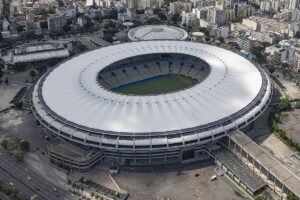
Maracana stadium, officially named Estádio Jornalista Mário Filho is an association football stadium in Rio de Janeiro, Brazil.
The stadium is part of a complex that includes an arena known by the name of Maracanãzinho, which means “The Little Maracanã” in Portuguese. Owned by the Rio de Janeiro state government, the stadium is now managed by the clubs Flamengo and Fluminense.
It is located at the Maracanã neighborhood, named after the Rio Maracanã, a now canalized river in Rio de Janeiro.
The stadium was opened in 1950 to host the FIFA World Cup, in which Brazil was beaten 2:1 by Uruguay in the deciding game, in front of a still standing record attendance of 173,850 spectators, on 16th July 1950.
The venue has seen attendances of 150,000 or more at 26 occasions, the last being on 29th May 1983, as 155,253 spectators watched Flamengo beat Santos, 3:0.
The stadium has seen crowds of more than 100,000 284 times. But as terraced sections have been replaced with seats over time, and after the renovation for the 2014 FIFA World Cup, its original capacity has been reduced to the current 78,838, but it remains the largest stadium in Brazil and the third largest in South America after Estadio Monumental in Peru.
The stadium is mainly used for football matches between the major football clubs in Rio de Janeiro, including Flamengo, Fluminense, Botafogo, and Vasco da Gama.
It has also hosted a number of concerts and other sporting events. It was the main venue of the 2007 Pan American Games, hosting the football tournament and the opening and closing ceremonies.
The Maracanã was partially rebuilt in preparation for the 2013 FIFA Confederations Cup, and the 2014 World Cup, for which it hosted several matches, including the final.
It also served as the venue for the opening and closing ceremonies of the 2016 Summer Olympics and Paralympics, with the main track and field events taking place at the Estádio Olímpico. The stadium was also chosen to host the 2020 and 2023 Copa Libertadores finals.
After winning the right to host the 1950 FIFA World Cup, the Brazilian government sought to build a new stadium for the tournament.
The construction of Maracanã was criticized by Carlos Lacerda, then Congressman and political enemy of the mayor of the city, general Ângelo Mendes de Morais, for the expense and for the chosen location of the stadium, arguing that it should be built in the West Zone neighborhood of Jacarepaguá.
At the time, a tennis stadium stood in the chosen area. Still it was supported by journalist Mário Filho, and Mendes de Morais was able to move the project forward.
The competition for the design and construction was opened by the municipality of Rio de Janeiro in 1947, with the construction contract awarded to engineer Humberto Menescal, and the architectural contract awarded to seven Brazilian architects, Michael Feldman, Waldir Ramos, Raphael Galvão, Oscar Valdetaro, Orlando Azevedo, Pedro Paulo Bernardes Bastos, and Antônio Dias Carneiro.
The first cornerstone was laid at the site of the stadium on 2nd August 1948. With the first World Cup game scheduled to be played on 24th June 1950, this left a little under two years to finish construction.
However, work quickly fell behind schedule, prompting FIFA to send Ottorino Barassi, the head of the Italian FA, who had organized the 1934 World Cup, to help in Rio de Janeiro.
A work force of 1,500 constructed the stadium, with an additional 2,000 working in the final months. Despite the stadium having come into use in 1950, the construction was only fully completed in 1965.
It is one of the most iconic football (soccer) stadiums in the world. With a seating capacity of over 78,000, it has hosted numerous historic matches, including the 1950 FIFA World Cup final.
The stadium has undergone renovations and upgrades over the years, and it has been used for various sporting events, concerts, and cultural activities. Its unique design and rich history make it a symbol of Brazilian sports culture.




